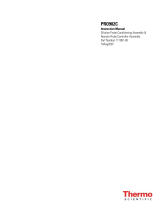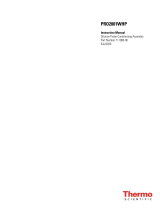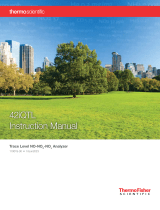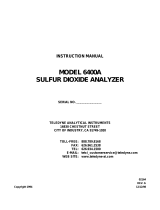Page is loading ...

The 220V option complies with 89/336/EEC directive for electromagnetic compatibility.
Model 200L
Instruction Manual
Single Dilution Probe Controller
Part Number 10519
20Dec2007

© 2007 Thermo Fisher Scientific Inc. All rights reserved.
Specifications, terms and pricing are subject to change. Not all products are available in all countries. Please
consult your local sales representative for details.
Thermo Fisher Scientific
Air Quality Instruments
27 Forge Parkway
Franklin, MA 02038
1-508-520-0430
www.thermo.com/aqi

Thermo Fisher Scientific WEEE Compliance
WEEE Compliance
This product is required to comply with the European Union’s Waste
Electrical & Electronic Equipment (WEEE) Directive 2002/96/EC. It is
marked with the following symbol:
Thermo Fisher Scientific has contracted with one or more
recycling/disposal companies in each EU Member State, and this product
should be disposed of or recycled through them. Further information on
Thermo Fisher Scientific’s compliance with these Directives, the recyclers
in your country, and information on Thermo Fisher Scientific products
which may assist the detection of substances subject to the RoHS Directive
are available at: www.thermo.com/WEEERoHS.


iii
TABLE OF CONTENTS
CHAPTER 1 INTRODUCTION .........................................................................1-1
Principle of Operation...................................................................................................... 1-1
Specifications................................................................................................................... 1-2
CHAPTER 2 INSTALLATION...........................................................................2-1
Lifting............................................................................................................................... 2-1
Unpacking ........................................................................................................................ 2-1
Installation Procedure ...................................................................................................... 2-2
System Plumbing Connections ....................................................................................... 2-2
Startup Procedure............................................................................................................. 2-3
CHAPTER 3 OPERATION ...............................................................................3-1
Electronics........................................................................................................................ 3-1
Relay Board...................................................................................................................... 3-1
Switch Board....................................................................................................................3-3
Rear Terminal Board........................................................................................................ 3-4
Gauges .............................................................................................................................. 3-6
Flow Description.............................................................................................................. 3-7
Subassemblies.................................................................................................................. 3-8
CHAPTER 4 CALIBRATION ............................................................................4-1
Equipment Required ........................................................................................................ 4-1
Dilution Probe..................................................................................................................4-1
Probe Technique .............................................................................................................. 4-2
Single Dilution Configuration.......................................................................................... 4-2
Dilution Calculations ....................................................................................................... 4-3

iv
CHAPTER 5 PREVENTIVE MAINTENANCE...................................................5-1
Safety Precautions............................................................................................................ 5-1
Replacement Parts List..................................................................................................... 5-1
Relay Board Replacement................................................................................................ 5-2
Switch Board Replacement.............................................................................................. 5-2
Precision Orifice Check ................................................................................................... 5-3
Span Solenoid Valve Check............................................................................................. 5-3
Flow Leak Check ............................................................................................................. 5-4
Spare Parts ....................................................................................................................... 5-4
Service Locations............................................................................................................. 5-5
CHAPTER 6 TROUBLESHOOTING ................................................................6-1
Troubleshooting Guide .................................................................................................... 6-1
APPENDIX A WARRANTY.............................................................................. A-1
APPENDIX B SCHEMATICS ..................................................................... B-1
LV200 AC Wiring Schematic..........................................................................................B-1
Main Control & Relay Board...........................................................................................B-2
200L Switch Board (Dual and Single) .............................................................................B-3
Terminal Board ................................................................................................................B-4

v
LIST OF ILLUSTRATIONS
Figure Page
2-1 Model 200L Front Panel ...................................................................................... 2-1
2-2 Model 200L Single Rear Panel ............................................................................ 2-2
2-3 Typical Single Probe Controller System Line Connections................................. 2-3
2-4 Dilution Probe...................................................................................................... 2-5
2-5 Sonic Orifice Assembly ....................................................................................... 2-6
3-1 Relay Board Assembly......................................................................................... 3-2
3-2 Switch Board Assembly....................................................................................... 3-3
3-3 Rear Terminal Board............................................................................................ 3-4
3-4 Rear Terminal Status and Remote Activation ..................................................... 3-5
3-5 Gauge Locations .................................................................................................. 3-6
3-6 Plumbing Diagram............................................................................................... 3-7
3-8 Case Bottom Assembly Layout............................................................................ 3-8
5-4 Span Valve Manifold Assembly .......................................................................... 5-3


vii
LIST OF TABLES
Table Page
4-1 Critical Orifice Sizes............................................................................................ 4-3
5-1 Replacement Parts................................................................................................ 5-1


1-1
CHAPTER 1
INTRODUCTION
Thermo Environmental Instruments is pleased to provide the Model 200L Single Dilution
Probe Controller. We are committed to the manufacture of instruments exhibiting high
standards of quality, performance, and workmanship. TEI service and support personnel
are available to provide assistance with any questions or problems that may arise in the
use of this controller.
The Model 200L Single Dilution Probe Controller allows configurations for systems requiring
the need for various dilutions. With an external source of high pressured air and calibration
cylinders, the dilution controller provides the necessary means of delivering different dilution
ratios in conjunction with one dilution probe. The controller is based on the engineering
design and selection of complete components having complimentary specifications which
result in a simple to operate, easy to adapt, high accuracy, and low maintenance.
PRINCIPLE OF OPERATION
The Model 200L Single Dilution Probe Controller is utilized in conjunction with various
dilution probe configurations. The dilution probe provides the means of the actual
dilution process. The dilution probe is where the actual dilution process occurs. The
Model 200L Single Dilution Probe Controller is designed to measure stack effluents by
mixing the exhaust gases with pressurized regulated zero air at a known dilution ratio.
This method meets the requirements pertained in the E.P.A. CFR Title 40, Part 60. A
critical orifice is affixed to the probe which draws the sample or span gas through to mix
with the pressure being delivered from the instrument’s controller unit. The critical
orifice selection determines which dilution setting is necessary to meet the customer’s
requirements. Ratios of 50:1, 100:1, 150:1, and 200:1 are the most common used
configurations for combustion or other various sample monitoring. The controller allows
the user to set the dilution ratio according to the customer’s dilution settings by means of
measuring combustion emissions or other sample gases. A relay board is used to switch
the flow streams for calibration gases. A front panel rotary switch is utilized in order to
switch from calibration gas streams 1 through 5, manually or externally from a data
acquisition system. The Model 200L Single Dilution Probe Controller provides for a
variety of dilution system requirements
The dilution ratio is calculated to decrease the water moisture in the sample gas to a
percent at which the water moisture remains suspended. The use of dry instrument air for
dilution ratios in the order of 100:1 results in a sample that is 99 percent clean and dry
zero air. This is an excellent sample for analyses with ambient air analyzers. High
accuracy and freedom from interferences is assured.

Chapter 1 Introduction
1-2
SPECIFICATIONS
Operating temperature 5o C to 45o C
Power Requirements 115/230 Volts ±10%, single -phase, 50/60 Hz,
90 Watts
Remote Inputs Ability to control zero, and 1 to 5 span ports.
Output Contacts Zero, and up to 5 spans.
Physical Dimensions 17" W x 7" H x 23" D
Weight 29 lbs.
Any alteration, modification, or republication of this instruction manual or any alteration or
modification to the Thermo Environmental Instrument product without the express written
consent of Thermo Environmental Instruments Inc. is expressly prohibited, nullifies our
warranty obligations, and bars our liability for any damages deriving therefrom.

2-1
CHAPTER 2
INSTALLATION
The installation of the Model 200L Single Dilution Probe Controller includes unpacking
the controller, connecting conditioning lines to the controller, and initial installation.
LIFTING
A procedure appropriate to lifting a heavy object should be used when lifting the
controller. This procedure consists of bending at the knees while keeping your back
straight and upright. The controller should be grasped at the bottom, in the front and at
the rear of the unit. Do not attempt to lift the controller by the cover or other external
fittings. While one person may lift the unit, it is desirable to have two persons lifting, one
by grasping the bottom in the front and the other by grasping the bottom in the rear.
UNPACKING
The Model 200L Single Dilution Probe Controller is shipped complete in one container.
If, upon receipt of the controller, there is obvious damage to the shipping container, notify
the carrier immediately and hold for inspection. The carrier, and not Thermo
Environmental Instruments Inc., is responsible for any damage incurred during shipment.
Follow the procedure below to unpack and inspect the controller.
1. Remove the controller from the shipping container and set on a table or bench that
allows easy access to both the front (Figure 2-1) and rear (Figure 2-2) of the
instrument.
2. Remove the controller cover to expose the internal components.
3. Remove any internal packing material.
4. Check for possible damage during shipment.
5. Check all connectors and printed circuit boards to see if they are firmly attached.
6. Re-install the controller cover.
Figure 2-1. Model 200L Front Panel

Chapter 2 Installation
2-2
56P712
Figure 2-2 Model 200L Single Rear Panel
INSTALLATION PROCEDURE
Before connecting any power or lines to the rear of the controller, refer to Figure 2-2 and
to the system documentation, if supplied, for any details which may not be included in
this manual. Check the Purchase Order packing slip to ensure that the unit was ordered
for the right configuration. If any of the information is incorrect, contact the Sales
Representative from which the unit was purchased or call a Sales Representative at
Thermo Environmental Instruments at 508-520-0430. Information in the system's
documentation will refer to more detailed wire connections and plumbing diagrams.
System documentation will be issued if the unit is supplied as a component of a larger
systems.
Before powering up of the Model 200L Single Dilution Probe Controller, make sure the
proper transformer configuration is correct for the proper outlet. Identify the rear panel
for appropriate outlet labeling. The transformer is marked accordingly to identify if the
transformer is for 110 AC or 220 AC. The cover will need to be removed to identify the
label on the transformer.
SYSTEM PLUMBING CONNECTIONS
Connecting the various lines to the rear panel of the Model 200L Single Dilution Probe
Controller is illustrated in Figure 2-3. If the unit was purchased with a system, please refer
to those appropriate documentation for proper connections. All tubing connected to the
controller is ¼" Teflon tubing. When the proper configuration complete and checked, the
startup procedure can be performed.

Chapter 2 Installation
2-3
STARTUP PROCEDURE
1. Connect the power cord to the rear of the unit and turn the power ON.
2. Check to make sure the power switch light is ON.
3. Monitor the indicator lights. Switch the selector switch from various positions to check
if all the LEDs are turning ON properly.
4. While moving the switch, listen for the solenoid valves to click into position and observe
that the appropriate LEDs turn ON in turn.
The Model 200L Single Dilution Probe Controller is now ready to be installed either in a
rack assembly or for test bench purposes. With the unit placed in a secured location, the
lines to the unit can be connected. Figure 2-3 illustrates a common connection to a rack
system for a Model 200L Single Dilution Probe Controller. Four major plumbing
connection lines, and the system plumbing configuration, are critical to the operation of the
controller. The four major plumbing lines are Diluted Air (DA), Diluted Sample (DS),
Vacuum Line (VL), and Calibration Line (CL).
Figure 2-3. Typical Single Probe Controller System Line Connections

Chapter 2 Installation
2-4
The connection lines from the dilution controller to the dilution sample probe should be
properly labeled and connected to the correct port fitting. A pressure of 60 to 80 psig of
clean zero air is supplied to the high pressure air inlet port. The air inlet is then reduced to
approximately 40 psig by a dilution air regulator. The desired dilution ratio is determined
after reviewing the application data. This dilution air is delivered to the sample probe. A
high performance venturi in the probe provides the vacuum that draws the sample through
the critical orifice. This sample is mixed with the dilution air and transported through the
sample transport bundle to the selected instruments for analysis. Figure 2-4 shows the stack
probe installation and connection details.

Chapter 2 Installation
2-5
Figure 2-4. Dilution Probe

Chapter 2 Installation
2-6
The sonic orifice uses a quartz wool to prevent sample particulates to enter the critical flow
passage. The quartz wool acts as a particulate filter (Figure 2-5). The quartz wool is
periodically changed every three months for continuous monitoring. The quartz wool is
placed into the end of the orifice against a glass frit. The glass critical orifice is attached to
the dilution nozzle/heat exchanger section with a graphite ferrule and nut. The mantel
section is carefully threaded onto the dilution nozzle/heat exchanger.
Figure 2-5. Sonic Orifice Assembly
CAUTION: This is a very fine threaded section and requires anti-seize
compound on the threads since this section will be located in the zone of the
source. Also, caution should be observed when unthreading this unit to prevent
breaking the glass critical orifice.

3-1
CHAPTER 3
OPERATION
In order to fully understand the operation of the Model 200L Single Dilution Probe
Controller, a general knowledge of the electronics, flow, and subassemblies is
recommended. A better understanding of the components themselves will allow the user
to correctly change parts or subassemblies more efficiently.
ELECTRONICS
The relay and switch boards are the primary active electronic circuit boards mounted in
the controller unit. A DC voltage of +24 is utilized from the relay board to activate the
solenoid valves. The position of the rotary switch on the front panel determines which
solenoid valve or valves are activated in order to allow air or gas flow through the Model
200L Single Dilution Probe Controller. The rear terminal board delivers dry contact
status output which can be connected to a data acquisition unit. The controller can be
activated remotely by a data acquisition unit or by solid state relay configurations.
RELAY BOARD
The relay board supplies +24 Volts to the solenoid valves, depending upon the position of
the switch. The relay board is part of the regulator-relay board assembly (Figure 3-1).
Three ribbon cables are attached to the relay board. One of the cable assemblies is
connected to the switch board assembly and the other two are connected to the rear
terminal board. The relay board controls the position of the valves and provides solid
state contacts to the rear connector board. The voltage from the transformer delivers
approximately +20 Volts AC, which is than converted to +24 Volts DC by four diodes
(see appendix B for relay board schematic for details). The +24 Volts DC goes through
the relay board and is delivered to the Switch Board Assembly. The switch from the
switch board assembly directs the +24 Volts DC to the appropriate solid state relay. A
¼ amp fuse is used for safety prevention of surge current while the unit is in the sample
mode.

Chapter 3 Operation
3-2
62P715
Figure 3-1. Relay Board Assembly
/













